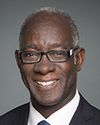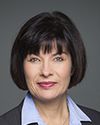Thank you very much.
I know invite Mr. Desilets to take the floor for two minutes.
Evidence of meeting #68 for Veterans Affairs in the 44th Parliament, 1st Session. (The original version is on Parliament’s site, as are the minutes.) The winning word was survey.
A video is available from Parliament.
5 p.m.
Liberal

The Chair Liberal Emmanuel Dubourg
Thank you very much.
I know invite Mr. Desilets to take the floor for two minutes.
5 p.m.
Bloc

Luc Desilets Bloc Rivière-des-Mille-Îles, QC
Thank you, Mr. Chair.
Ms. Edwards, as I understand it, there aren't a lot of statistics on health issues that women may suffer in the armed forces. I'm still thinking about what you said about mastectomies.
What organization would be responsible for examining this issue? We have to get to a point where we can put numbers on this. Are you the only woman in this situation in Canada? Are there 200 of you? Is this a common practice?
Who should be responsible for studying this phenomenon?
5 p.m.
Researcher, As an Individual
Some of it didn't come through, but I think I got what you're saying.
You're wondering who should be responsible for researching the physical health of women veterans. If that is the case, we need to first have an injury surveillance system through the CAF, so that when they come out of service, we can understand. If it wasn't documented in their medical chart....
Seventy-five per cent of overuse injuries were reported by females. That means 25% of the overuse injuries are not being reported. That's a pretty substantial number. If we have injury trends per military trade, we can assume that the likelihood of someone having a certain injury because they worked in a certain trade is pretty high. I would say that, on the CAF level, we need to identify what's going on.
There's also VAC. On the first day of basic training, a CAF member potentially could be someone who relies on VAC, so why don't we have that connection right away instead of waiting until they're injured or releasing to start building that connection? It would make a lot of sense for VAC to be involved in monitoring the injuries that are happening during service, or they could document what injuries are being reported to them afterwards. If they start noticing trends, we can start intervening on that.
Again, we need to start tracking what's going on with our members and our veterans before we can start to build any solutions.
5:05 p.m.
Liberal

The Chair Liberal Emmanuel Dubourg
Thank you very much.
Now, Ms. Blaney, you have the floor for two minutes.
5:05 p.m.
NDP

Rachel Blaney NDP North Island—Powell River, BC
Thank you, Mr. Chair.
Perhaps I will come back to you, Ms. Edwards.
Can you explain what you mean by including female biology in training and—in that context—clarify what this means for both service in CAF and the reality of VAC?
5:05 p.m.
Researcher, As an Individual
Yes.
I am speaking about training the medical side. Our medics should receive women's health training. They are supporting our female members. They are their first line. Our doctors also should be receiving women's health.... If we don't want to allocate resources to that, provide a women's health specialist. Some bases used to have a women's health nurse practitioner. A lot of them don't have that anymore. That would be an alternative. If you aren't comfortable having certain people ask those types of questions, allocate someone to do it.
We don't train our leaders in how to support their female members either. They won't know how to support a female who is, maybe, experiencing postpartum depression when returning back to duty. Leadership should notice when their members aren't doing well. However, if they don't know the questions to ask, they won't ask. How do we support a female who is...?
Another aspect is RED-S, which is relative energy deficiency. Females are at a greater risk of experiencing this. For anyone who has a daughter or who has played sports, this is a common issue brought up in sports right now around girls and women athletes.
Actually, female service members are in the same category. They're at high risk for this. It increases their risk of repetitive strain injuries, including stress fractures. A pelvic stress fracture or a hip stress fracture impacts females at a higher rate in basic training and throughout their careers. If we're not asking the question, “Hey, is your menstrual cycle regular?”.... That question is actually too late. We see the physiology actually change before that symptom arises to indicate RED-S is possible. Irregular menstrual cycles also have a risk of increased injury. It also impacts reproductive health.
5:05 p.m.
Liberal

The Chair Liberal Emmanuel Dubourg
Thank you very much, Ms. Edwards.
That concludes the hour that was allotted to us to discuss the experience of women veterans.
On behalf of the committee members, I would like to thank the witnesses for coming.
We heard from Chris Edwards, who testified as an individual, as well as Mélanie Morin‑Pelletier, from the Canadian War Museum, and Debbie Lowther, chief executive officer and co‑founder of Veterans Emergency Transition Services.
We will suspend for two minutes so we can greet the witnesses and move on to the second hour.
5:15 p.m.
Liberal

The Chair Liberal Emmanuel Dubourg
We will resume.
Mesdames et messieurs, for the second hour, pursuant to Standing Order 108(2) and the motion adopted by the committee on Thursday, March 9, 2023, the committee is commencing its study of the national monument to Canada’s mission in Afghanistan.
Before welcoming my colleagues, I would simply like to provide a brief reminder regarding ground rules.
The following routine motions were adopted at the committee's first meeting of this session:
That only the clerk of the committee be authorized to distribute documents to members of the committee and only when such documents exist in both official languages, and that witnesses be advised accordingly. That all documents submitted for committee business that do not come from a federal department, member's offices, the office of the clerk of the committee and the office of the analyst or that have not been translated by the Translation Bureau be sent for prior linguistic review by the Translation Bureau before being distributed to members.
That's what we've been seeing recently. We can't prevent people from sending emails directly to other members, but it's important that those emails be translated in order to be official. If the report mentions it, then those reports can subsequently be cited.
With that, I want to greet our colleague Mr. Paul‑Hus, who is replacing Mr. Dowdall. I would also like to welcome witnesses who are here with us for the second hour.
Ladies and gentlemen, we have the Honourable Ginette Petitpas Taylor, Minister of Veterans Affairs, and the Honourable Pascale St‑Onge, Minister of Canadian Heritage.
From the Department of Canadian Heritage, we also have deputy minister Isabelle Mondou. She is joined by Emmanuelle Sajous, assistant deputy minister, sport, major events and commemorations.
From the Department of Veterans affairs, we have Paul Ledwell, who is a committee regular, and Amy Meunier, assistant deputy minister, commemoration and public affairs branch.
There will be a period of questions, but first the ministers will deliver their opening statements.
I would like to invite the Honourable Pascale St‑Onge to make her presentation.
You have five minutes.
5:20 p.m.
Brome—Missisquoi Québec
Liberal

Pascale St-Onge LiberalMinister of Canadian Heritage
Thank you, Mr. Chair.
Good afternoon, Mr. Chair, committee members and colleagues.
First, I'd like to acknowledge that we are gathered on the traditional territory of the Algonquin Anishinabeg.
At your request, I appear before you today to discuss the selection of the design for the National Monument to Canada's Mission in Afghanistan.
My presentation will be shorter than the five minutes you have allotted me.
I must say that the Department of Canadian Heritage played a strictly administrative and support role in this project.
The department shared its expertise on the organization of the design competition with Veterans Affairs Canada, and that is why I am going to yield to my colleague, the Minister of Veterans Affairs, who will explain why the government has made this decision.
Thank you very much.
5:20 p.m.
Liberal

The Chair Liberal Emmanuel Dubourg
Thank you, Minister.
I now invite the Honourable Ginette Petitpas Taylor to deliver her statement.
You have the floor for five minutes.
October 31st, 2023 / 5:20 p.m.
Moncton—Riverview—Dieppe New Brunswick
Liberal

Ginette Petitpas Taylor LiberalMinister of Veterans Affairs
Thank you very much, Mr. Chair.
Mr. Chair and members of the committee, thank you for inviting me to appear before you once again to discuss the National Monument to Canada's Mission in Afghanistan.
From October 2001 to March 2014, Canada took part in its most complex mission since the Korean War. More than 40,000 uniformed Canadians and hundreds of civilians and government representatives served in Afghanistan and the surrounding region, from the departure of the first ships until the last troops returned.
Tragically, 158 members of our Canadian Armed Forces died in service to the mission along with seven Canadian civilians. Thousands more returned physically and psychologically wounded, many with permanent scars that they have had to live with ever since.
In 2019, our government announced that a national monument to Canada's mission in Afghanistan would be designed and built at LeBreton Flats, right here in Ottawa. Its purpose would be to give Canadians a permanent place to reflect on the service, commitment and sacrifice of those who served in Afghanistan and the support provided to them at home.
Veterans Affairs Canada and the Department of Canadian Heritage opened a joint design competition in August of that same year. Teams of professional artists, architects and landscape architects, as well as other urban design professionals, were invited to submit references and samples of previous projects for consideration.
It was understood from the outset that veterans, the families of members fallen in combat, serving members and the public at large would be invited to consider the finalists' proposals before a design concept was selected by an expert jury.
Five team finalists were ultimately selected. After their design concepts were unveiled in May 2021, Canadians had an opportunity to express their opinion of their preferred design concept from among the five finalists selected by the jury.
After 12,048 valid online surveys were analyzed, the entry from Team Stimson was found to have resonated most with respondents, receiving between 52% and 64.8% support across all questions. In other words, a preferred design concept emerged from the online survey, at least among veterans, those who served in Canada's mission in Afghanistan, their family members, serving members and the public. The results were compelling, and, as such, the Government of Canada decided to listen to veterans and those with a connection to the mission in Afghanistan in selecting the preferred design concept.
Based on that information, and following a careful review, the Government of Canada selected the design concept of Team Stimson for the National Monument to Canada's Mission in Afghanistan, and that selection was announced at the Canadian War Museum in June of this year.
We thank the five teams for the time and effort they put into this important project. We deeply appreciate and respect the work done by the members of the jury who reviewed the many entries before selecting and evaluating the five design finalists.
The professionalism and personal experience of the jury were much appreciated and were an integral part of the process. However, it became clear as the process advanced that the contribution of veterans and individuals associated with the mission had to be a decisive factor in selecting the design concept.
Mr. Chair and members of the committee, as we approach Veterans' Week and Remembrance Day next month, Canadians will soon be reflecting on what so many have given up in the name of peace, freedom, human rights and democracy in the world.
In Afghanistan, our troops suffered devastating losses of life and debilitating physical and psychological injuries.
We owe these veterans a debt that we may never entirely be able to repay. Consequently, the least we can do is select the design that best corresponds to the monument that the veterans and individuals associated with the Afghanistan mission wish to see erected. This is an excellent way to express our gratitude for their service.
Thank you once again for inviting me to be with you today.
We will be pleased to answer your questions.
5:25 p.m.
Liberal

The Chair Liberal Emmanuel Dubourg
Thank you very much for your remarks. In both cases, you used all of your five minutes. Consequently, we will be able to ask more questions.
I'd like to invite committee members to check their timer to see how much time they have left. They don't often look at me when I signal to them that time is up.
Ms. Petitpas Taylor, since you speak extremely quickly, I would ask you please to speak more slowly so the interpreters can follow you.
And with that, we will proceed as we did in the previous session, when we had great discussions without interruptions.
So, without further ado, I invite Mr. Paul‑Hus to take the floor for six minutes in this first round of questions.
5:25 p.m.
Conservative

Pierre Paul-Hus Conservative Charlesbourg—Haute-Saint-Charles, QC
Thank you, Mr. Chair.
Good afternoon, ministers and members of the committee.
We are here today mainly to discuss the selection process for the National Monument to Canada's Mission in Afghanistan.
I wouldn't say the process was botched. On the contrary, it was very well executed by the jury members and the team of professionals, who did their job and selected Team Daoust, from Quebec, with Luca Fortin, an artist from the Quebec City region, where I come from.
The big surprise, the shock, was seeing that the decision changed. In our view, the decision to change teams and select Team Stimson was an arbitrary one on the government's part. We're trying to understand it, but no one understands it. The community doesn't understand it either. Businesses working in the design world at the national and international levels don't understand it. No one understands how this work, which was done by a professional jury, could have been dismissed out of hand.
You talked about veterans. I'm a veteran. You don't need to explain veteran world to me? I know all about it. We're here today to understand how the decision was made.
You mentioned the survey. The Léger firm conducted a detailed study that completely demolished that survey. I saw the table of figures and data that were collected. It makes no sense from the point of view of professional statistics. You can't rely on it to make this kind of decision and completely disregard a professional jury that did its job in selecting the project of another team.
In that connection, Ms. St‑Onge, I'd like to go back to what you said earlier. You said that the Department of Canadian Heritage washed its hands of the matter because the department played a more administrative role. I would note that, in early 2023, your predecessor, Mr. Rodriguez, received a memo from the assistant deputy minister stating that his permission was required in order to authorize a change. I of course can't see all the most interesting parts of the memo because they're obviously redacted. Whatever the case may be, the permission of the Minister of Canadian Heritage was required.
We're talking about artists and designers. You are responsible for everything pertaining to monuments in Canada. This kind of project can't simply be dismissed out of hand. Don't you have an opinion about the way this was handled?
5:25 p.m.
Liberal

Pascale St-Onge Liberal Brome—Missisquoi, QC
As you said, the Minister of Canadian Heritage has the authority and it's up to that minister to ratify the government's decision to abide by the consultation that took place.
5:25 p.m.
Conservative

Pierre Paul-Hus Conservative Charlesbourg—Haute-Saint-Charles, QC
You mentioned the government's decision to accept the recommendation of the Department of Veterans Affairs, which requested a change to the project. That's what happened.
5:25 p.m.
Liberal

Pascale St-Onge Liberal Brome—Missisquoi, QC
I'm talking about the consultation that was conducted of veterans and the government's decision to accept their preferences.
My predecessor simply ratified the government's decision.
5:30 p.m.
Conservative

Pierre Paul-Hus Conservative Charlesbourg—Haute-Saint-Charles, QC
As Minister of Canadian Heritage, you can now see that the work of professionals and a jury was dismissed out of hand even though the veterans' comments had been considered. The team had taken the survey into consideration. The jury nevertheless selected Team Daoust from Montreal. Suddenly, in May, we saw that Mr. Rodriguez had signed a memo on February 15 and said there was no problem, that the other team could be selected.
Why? What's the real reason? We want to know why the other team was selected, when everything had been properly done.
5:30 p.m.
Liberal

Pascale St-Onge Liberal Brome—Missisquoi, QC
My colleague the Minister of Veterans Affairs clearly explained the decision that was made in her introductory remarks. She clearly explained that the veterans, their families and the people who took part in the Afghanistan mission on Canada's behalf were consulted and that the government made this decision to accept their preferences.
5:30 p.m.
Conservative

Pierre Paul-Hus Conservative Charlesbourg—Haute-Saint-Charles, QC
Léger determined that the survey had no scientific value. Anybody could have voted without really being a veteran. The data really weren't reliable, but that was apparently enough to completely dismiss the work of a professional jury and its decision to select Team Daoust. Instead an arbitrary decision was made to rely on data that wasn't really reliable.
There are other reasons. Why was Team Stimson selected? It wasn't based simply on an unscientific survey.
5:30 p.m.
Liberal

Ginette Petitpas Taylor Liberal Moncton—Riverview—Dieppe, NB
It seems very clear to me. We talked about surveys, questionnaires and consultations. We never said it was a scientific survey.
We wanted to hear veterans' opinions because this is about a monument commemorating the Canadian mission in Afghanistan. The Department of Veteran Affairs is the project leader for this monument.
First, we sent messages out to veterans who had access to My VAC Account. We wanted to ensure that veterans were aware that the consultation was being conducted.
Then we sent a message to families that had lost loved ones in the Afghanistan mission. We also sent messages to all stakeholders working with veterans, such as Canadian legions, to ensure that the message would be put out there.
To our great surprise, more than 12,000 Canadians responded to that survey.
5:30 p.m.
Conservative

Pierre Paul-Hus Conservative Charlesbourg—Haute-Saint-Charles, QC
Minister, I don't know whether you've seen the report prepared by Jean‑Marc Léger, of the Léger firm, the largest survey firm in Canada.
[These numerous methodological errors show that this online survey was unscientific and does not in any way represent the opinions of our armed forces members, or their family members, or even of Canada's population. The results of the online survey cannot be generalized to Canada's population and ought not to be given consideration in an objective process to select a design for the national monument to Canada's mission in Afghanistan.]
5:30 p.m.
Conservative

Pierre Paul-Hus Conservative Charlesbourg—Haute-Saint-Charles, QC
A jury of experts was completely abandoned for a survey which, according to you, represented the opinions of veterans, even though the Léger firm analyzed the data and told us it was worthless.
5:30 p.m.
Liberal

Ginette Petitpas Taylor Liberal Moncton—Riverview—Dieppe, NB
Mr. Paul‑Hus, first of all, we never set aside the jury. It did extraordinary work, at the end of which there were five finalists. However, for the final decision, the key factor was what veterans told us. That's why we chose—
5:30 p.m.
Conservative

Pierre Paul-Hus Conservative Charlesbourg—Haute-Saint-Charles, QC
And yet, the Daoust team had been selected—